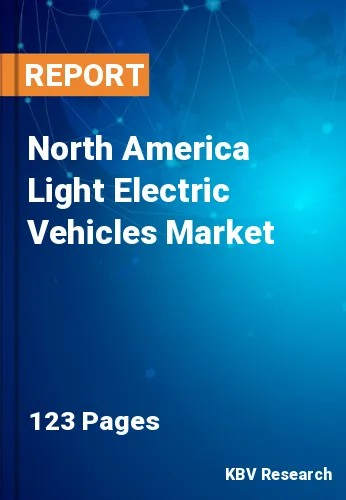The North America Light Electric Vehicles Market would witness market growth of 8.3% CAGR during the forecast period (2022-2028).
EVs have experienced a comeback in the 21st century due to technology advancements, a greater emphasis on renewable energy, and the possible reduction of transportation's influence on climate change, pollution, and other environmental issues. Project Drawdown identifies electric vehicles as one of the 100 most effective modern approaches to combating climate change.
The majority of electric vehicles are powered by lithium-ion batteries (Li-Ions or LIBs). Lithium-ion batteries have a better energy density, a longer lifespan, and a higher power density than the majority of other commercially available batteries. Safety, longevity, thermal breakdown, environmental impact, and cost are complicating factors.
Li-ion batteries must be utilized within the safe temperature and voltage ranges for optimal performance. Increasing the battery's lifespan reduces operational expenses. Operating a subset of the battery cells at a time and swapping these subsets is one method. In the past, some electric cars, such as those manufactured by General Motors, utilized nickel–metal hydride batteries. These battery types are deemed obsolete because they tend to self-discharge in high temperatures.
The government is taking numerous measures to combat climate change, expand access to renewable energy options, and reduce the United States' dependency on oil. Today, the Administration unveiled a range of extraordinary efforts from the federal government, the business sector, and the states for 2016. These initiatives include a new framework for automakers, electric car charging firms, electric utilities, and states to collaborate to expedite the development of electric vehicle charging infrastructure.
The US market dominated the North America Light Electric Vehicles Market by Country in 2021, and would continue to be a dominant market till 2028; thereby, achieving a market value of $22,624.8 million by 2028. The Canada market is poised to grow at a CAGR of 10.8% during (2022 - 2028). Additionally, The Mexico market would witness a CAGR of 9.8% during (2022 - 2028).
Based on Vehicle Category, the market is segmented into 2-wheelers, 3-wheelers, and 4-wheelers. Based on Vehicle Type, the market is segmented into e-scooter, e-ATV/UTV, Neighborhood Electric Vehicle, e-bike & Motorcycle, e-lawn Mower, Autonomous Forklifts, Delivery Robots & Electric Industrial Vehicle, and Others. Based on Component Type, the market is segmented into Battery Pack, Electric Motor, Motor Controller & Power Controller, Inverters, and e-brake Booster & Power Electronics. Based on Application, the market is segmented into Personal Mobility, Shared Mobility, Recreation & Sports, and Commercial. Based on Power Output, the market is segmented into Less than 6 kW, 6-9 kW, and 9-15 kW. Based on countries, the market is segmented into U.S., Mexico, Canada, and Rest of North America.
Free Valuable Insights: The Global Light Electric Vehicles Market is Estimated to reach $130.4 Billion by 2028, at a CAGR of 8.9%
The market research report covers the analysis of key stake holders of the market. Key companies profiled in the report include Tesla, Inc., BMW Group, Columbia Vehicle Group Inc. (Nordic Group of Companies, Ltd.), Godrej Group (Godrej Material Handling), Kion Group, Yamaha Motor Co., Ltd., Textron, Inc., Polaris, Inc., BYD Company Ltd., and Toyota Industries Corporation.
By Vehicle Category
By Vehicle Type
By Component Type
By Application
By Power Output
By Country
Our team of dedicated experts can provide you with attractive expansion opportunities for your business.

